Kinnow exporters seek govt’s help
Extreme weather, water scarcity eat into citrus fruit production

All stakeholders in kinnow production and exports have sought the government’s assistance in coping with the emerging challenges because of climate change and extreme weather events.
Kinnow exports are expected to begin in the first week of December while the export price has been set at Rs2,000 per maund, according to a notification of the district administration, because of lower output.
“Consumers may have to pay more for kinnow this time around,” remarked Ahmad Jawad, CEO of Pakistan Businesses Forum.
In order to facilitate exporters, he stressed, the State Bank of Pakistan (SBP) should timely issue E-forms and make special arrangements for establishing banking channels, for shipments particularly to the Iranian and Russian markets.
Jawad lamented that the SBP could not open formal banking channels for the two critical markets over the last couple of years.
“Iranian market can absorb between 60,000 and 80,000 tons of kinnow, while the size of the Russian-Ukrainian-Belarus market (the largest citrus importing region in the world) for Pakistani citrus fruit may double from the current level of around 50,000 tons in no time,” he projected.
“This season, kinnow production has dropped by 50% due to acute canal water scarcity and unexpectedly high temperatures during the flowering stage of plants,” he pointed out.
Disappointed with the erratic canal water supply, kinnow export target will be fixed at a lower level at around 250,000 tons this season. “Although water has been in surplus quantity this year, temperature is an issue, which has affected our horticultural products,” Mahmood Nawaz Shah, an agricultural expert, told The Express Tribune.
In the absence of official figures, the estimates of production loss may vary.
“It seems kinnow production will be lower by 36% this year due to the impact of heat at the flowering stage,” said Hamid Malik, a Punjab-based farmer.
“However, I strongly believe that kinnow exports may not feel the pinch. Reasons for this are the reduction in sea freight rates, more availability of containers and weakening of Pakistani rupee versus global currencies,” he added.
Bayer Crop Science Grower Marketing Lead Azeem Khan Niazi pointed out that fresh kinnows had a high share in exports at 17-20% and major export markets for Pakistan comprised Russia and Far Eastern states.
According to Niazi, the Russian market prefers a smaller size fruit, whereas the ethnic Chinese buyers like the larger fruit with little or zero blemish. “This requirement has continued to pile on the pressure on fruit processors as they struggle to process a large quantity of the high-grade citrus.”
The decline in output and water shortage would have two consequences, Niazi said. First, it will make the availability of “A” grade produce even more difficult and will push up the cost of processing. Second, the fruit size and quality will also be impacted.
With average annual harvest of 2.4 million tons, the citrus fruit contributes about 30% to the total fruit production in Pakistan, which is increasing at an annual rate of 1.5% over the past two decades. During this period, annual exports of the citrus fruit have expanded by 17%.
Published in The Express Tribune, November 25th, 2022.
Like Business on Facebook, follow @TribuneBiz on Twitter to stay informed and join in the conversation.


















COMMENTS
Comments are moderated and generally will be posted if they are on-topic and not abusive.
For more information, please see our Comments FAQ